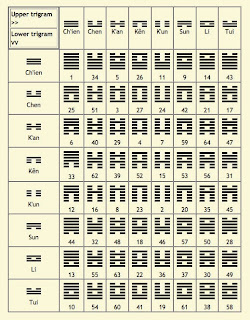 In all those old philosophies, Qi expresses the life force which animates the forms of the world. It is the vital energy or circulating life force that is thought to be inherent in all things. A living being is filled with it. A dead person has no more Qi - the warmth, the life energy is gone. The Egyptian described the same concept very similarly. A living person has the Ka and in a dead one Ka left the body. They also believed that the Ka was sustained through food and drink. This is then the reason why food and drink offerings were presented to the dead. In traditional Chinese medicine, Qi is believed to regulate a person’s spiritual, emotional, mental, and physical balance. A healthy individual has more Qi than one who is ill. However, health is more than an abundance of Qi. Health implies that the Qi in our bodies is clear rather than polluted and turbid; it is flowing smoothly like a stream and does not appear to be blocked or stagnant.
In all those old philosophies, Qi expresses the life force which animates the forms of the world. It is the vital energy or circulating life force that is thought to be inherent in all things. A living being is filled with it. A dead person has no more Qi - the warmth, the life energy is gone. The Egyptian described the same concept very similarly. A living person has the Ka and in a dead one Ka left the body. They also believed that the Ka was sustained through food and drink. This is then the reason why food and drink offerings were presented to the dead. In traditional Chinese medicine, Qi is believed to regulate a person’s spiritual, emotional, mental, and physical balance. A healthy individual has more Qi than one who is ill. However, health is more than an abundance of Qi. Health implies that the Qi in our bodies is clear rather than polluted and turbid; it is flowing smoothly like a stream and does not appear to be blocked or stagnant. In martial arts (or acupuncture) the capacity to perceive the flow of Qi or to actually see or feel it, is something that can be cultivated through Qi Gong training. During the practice one cultivates the capacity to perceive Qi on different levels. It seems like a potential to be yet expressed. One could say it is like fullness and/or emptiness (compared to yin and yang concept) when we perceive ourselves and the world around as fluid and spacious. In those concepts it is not just experiencing our body to be comprised of patterns and flows of Qì, but we also get to understand that ‘emotions’ and ‘thoughts’ are forms of energy. When a person understands this concept, it is possible to control and deviate the opponent’s energy with our own. Posing the question “Have you ever tried to pick up a child or a dog who did not want to be lifted?” Joe Hyams offers the result: “They both seem to be heavier—this is because the mind is truly a source of power, and when a mind and body are coordinated, Qi manifests itself.”
In martial arts (or acupuncture) the capacity to perceive the flow of Qi or to actually see or feel it, is something that can be cultivated through Qi Gong training. During the practice one cultivates the capacity to perceive Qi on different levels. It seems like a potential to be yet expressed. One could say it is like fullness and/or emptiness (compared to yin and yang concept) when we perceive ourselves and the world around as fluid and spacious. In those concepts it is not just experiencing our body to be comprised of patterns and flows of Qì, but we also get to understand that ‘emotions’ and ‘thoughts’ are forms of energy. When a person understands this concept, it is possible to control and deviate the opponent’s energy with our own. Posing the question “Have you ever tried to pick up a child or a dog who did not want to be lifted?” Joe Hyams offers the result: “They both seem to be heavier—this is because the mind is truly a source of power, and when a mind and body are coordinated, Qi manifests itself.”But Qi is more than the above. It is also the life energy one senses in Nature, the vibratory nature of any phenomena, the flow and tremor that is happening continuously at molecular, atomic and subatomic levels. The Earth itself is also moving, transforming, breathing, and alive with it.








